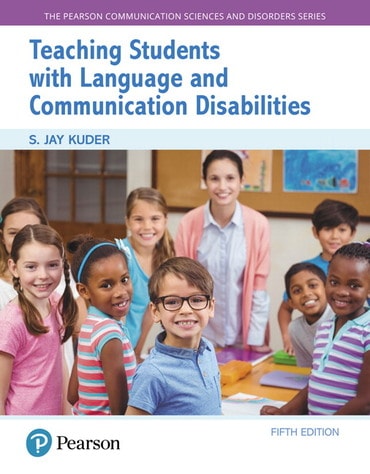
Title overview
-
Discusses language difficulties within the context of specific disability types including learning disabilities, intellectual disabilities, autism spectrum disorders, emotional and behavioral disorders, sensory disabilities, and neuromotor disabilities.
-
Explores the connection between language and literacy by devoting a complete chapter to the topic (Chapter 6), as well as sections within specific chapters.
-
Helps prepare teachers to work with students with more severe disabilities by including strong coverage of augmentative and alternative communication.
-
Applies and extends concepts to classroom situations.
-
Student vignettes in disability chapters help readers understand the impact of language disabilities in the classroom.
-
Teacher perspectives in disability chapters help readers understand real situations they may face as teachers of students with language disorders.
-
Literacy sections in disability chapters address the emerging research on literacy and disabilities and the state requirements that all students must develop literacy skills.
-
Review questions, case studies, and chapter activities encourage readers to apply the material and analyse the results.
-
Website links direct students to Internet resources that extend and enhance the content of the text.
-
-
Keeps students current on the latest research literature in the field by addressing emerging research on language difficulties of students not often thought of as having language disorders–including those with emotional and behavioral disorders and those with neurodevelopmental disorders.
-
Considers the implications of cultural diversity and the needs of English Language Learners (Chapter 16).
-
Updates information on the Response to Intervention (RtI) model as it increases in prevalence in the United States through reconceptualised Chapters 13 and 14.
-
Expands discussions of emerging technologies, such as the use of mobile apps that are enabling teachers to provide more individualised instruction to students at a lower cost.
Invigorate learning with the Enhanced Pearson eText
The Enhanced Pearson eText provides a rich, interactive learning environment designed to improve student mastery of content with the following multimedia features:
NEW! Embedded videos in each chapter illustrate key concepts and strategies.
NEW! Check Your Understanding quizzes at the end of each chapter section ensure comprehension of key concepts. Students answer multiple-choice questions and are provided with immediate feedback.
NEW! Apply Your Knowledge exercises help students apply and internalize key concepts. Students respond to short-answer questions and are provided with immediate feedback.
Students can experience the advantages of the Enhanced Pearson eText along with all the benefits of print for 40% to 50% less than a print bound book! Students, register for or purchase your eText at pearsonhighered.com/etextbooks/ted. Instructors, visit pearsonhighered.com/etextbooks/ted to register for your digital examination copy.
Key content changes include:
UPDATED! Considers the implications of cultural diversity and the needs of English Language Learners (Chapter 16).
Keeps students current on the latest research literature in the field by addressing emerging research on language difficulties of students not often thought of as having language disorders–including those with emotional and behavioral disorders and those with neurodevelopmental disorders.
UPDATED! Updates information on the Response to Intervention (RtI) model as it increases in prevalence in the United States through reconceptualized Chapters 13 and 14.
UPDATED! Expands discussions of emerging technologies, such as the use of mobile apps that are enabling teachers to provide more individualized instruction to students at a lower cost.
Table of contents
Chapter 2. Understanding the Elements of Language
Chapter 3. Language Acquisition: Bases and Models of Language Development
Chapter 4. Language Acquisition Models
Chapter 5. Language Development: Birth through the Preschool Years
Chapter 6. Language and Literacy in the School Years
Chapter 7. Language and Students with Learning Disabilities and Students with Attention Deficit Hyperactivity Disorder
Chapter 8. Language and Students with Intellectual Disabilities
Chapter 9. Language and Students with Autism Spectrum Disorders
Chapter 10. Language and Students with Emotional and Behavioral Disorders
Chapter 11. Language and Students with Sensory Disabilities
Chapter 12. Language and Students with Neuromotor Disabilities and Traumatic Brain Injury
Chapter 13. Language Assessment and Instruction in the Classroom
Chapter 14. Intensive Language and Communication Assessment and Instruction
Chapter 15. Augmentative and Alternative Communication
Chapter 16. Language, Culture, and English Language Learners
Author bios
S. Jay Kuder is a professor in the Department of Interdisciplinary and Inclusive Education at Rowan University in Glassboro, NJ., where he coordinates the graduate programs in special education and autism. Dr. Kuder’s research interests are in the development of effective practices for enhancing the language and literacy skills of children with disabilities. His recent research has focused on the use of technology to enhance communication and social skills in students with autism spectrum disorders. Dr. Kuder holds a masters degree in special education from Temple University and a doctoral degree in applied psycholinguistics from Boston University. He is a member of the American Speech-Language-Hearing Association, the Council for Exceptional Children, and a fellow of the American Association on Intellectual Disabilities, and has served on the New Jersey Special Education advisory board.